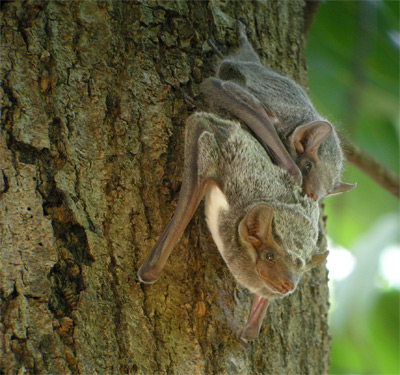
|
Search JoyZine with Google Site Search! |
Arnhem Sheathtail Bat Taphozous kapalgensis
The bat has been found in floodplains, mangroves, patchy monsoon forests and nearby woodlands. The roosting habitats are not clear. Because it has been recorded in the Northern Territory up to 70km from the nearest rocky habitats, it is likely to roost in tree hollows or similar situations, and some Aboriginal people claim that it roosts at the base of pandanus leaves. The species flies above the tree canopy, but it may be found closer to the ground in open areas. Males have a small pouch on the throat whereas females do not. The back of the Arnhem sheathtail bat is a solid brown and the underside is a light grey. There are some orange hues on the face. A white stripe of fur located on the flank of each wing (on the underside) makes it possible to get a glimpse of this bat in flight. There is no membrane on the tail. It weighs about 26g, the head and body measure about 71mm, and the forearm measures about 60mm. Some have heard the loud shrills made by this species when it feeds coming from woodlands and dense forests. This call is only made when bat is feeding. The diet of the Arnhem sheathtail bat consists of flying insects that are hunted by flying low over water and over eucalyptus forests. Threats to the species include large-scale modification from invasion of large areas of coastal floodplain by introduced plant species, replacement of natural floodplain vegetation with introduced pasture species, degradation of habitats by introduced water buffalo, and saltwater intrusion into the coastal plains, resulting in the deaths of large stands of melaleuca trees. If this species is found to roost in Pandanus, then fire may also be a threat. Its status is near threatened in the Northern Territory though it is not listed on Australia's list of endangered animals. However some attribute that to the lack of data on this species. With only 11 specimens, the Arnhem sheathtail bat is very rare. Scientists are concerned that the loss of the animal's natural habitat and feeding sites makes this species vulnerable. The species hasn't shown any signs of population decline which is due to a lack of data. The current primary conservation effort is to improve tracking of this species to gain more information. Further studies are needed into the distribution, abundance, natural history, and threats to this little-known species, particularly regarding roost sites. |
